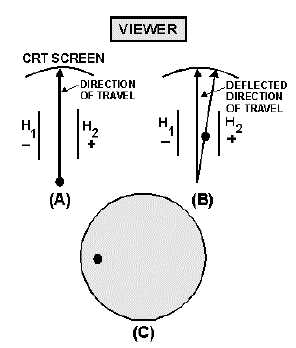2-23
These same principles also apply to the CRT used in your use of your major tool: the
OSCILLOSCOPE. Remember, the unique function of a CRT is to convert electronic (and electrical)
signals to a visual display. This function of a CRT is used in the oscilloscope to show the waveform of an
electronic signal. To help you understand better how an oscilloscope works, we will discuss the type of
deflection used in oscilloscopes. Bear in mind that the following discussion is only about deflection; we
will cover the actual operation of an oscilloscope in a later NEETS module that deals specifically with
test equipment.
Electrostatic Deflection
As you should know, there are two ways to move an electron (and thus an electron beam): either
with a magnetic or with an electrostatic field. Because of this, there are three possible ways to move or
deflect an electron beam in a CRT: magnetically, electromagnetically, and electrostatically. All three
ways are used in electronics. In general, though, electrostatic and electromagnetic deflection are used
most often. Your TV set, for example, uses electromagnetic deflection, while much of the test equipment
in the Navy uses electrostatic deflection.
ELECTROSTATIC DEFLECTION uses principles you are already familiar with. Namely,
opposites attract, and likes repel. Look at figure 2-24, view A. Here you see an electron traveling between
two charged plates, H1 and H2. As you can see, before the electron reaches the charged plates, called
DEFLECTION PLATES, its flight path is toward the center of the screen. In view B, the electron has
reached the area of the deflection plates and is attracted toward the positive plate, H2, while being
repelled from the negative plate, H1. As a result, the electron is deflected to the right on the inside of the
screen. You, the viewer, will see the spot of light on the left side of the CRT face (remember, you are on
the opposite side of the CRT screen). This is shown in view C.
Figure 2-24.—Deflection in a CRT.
A spot of light on the left-hand side of the CRT screen, however, is no more useful than a spot of
light in the center of the screen. To be useful, this spot will have to be converted to a bright line, called a
sweep, across the face of the CRT screen. We will explain the manner in which this is done by using



